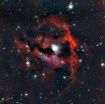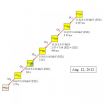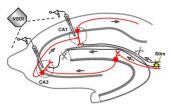(Press-News.org) For the first time in decades, researchers have conducted an extensive exploration for deep-sea corals and sponges in submarine canyons off the northeastern coast of the US. The survey revealed coral "hotspots," and found that a new coral habitat suitability model could help predict where corals are likely to occur. The model is being developed by the Northeast Fisheries Science Center (NEFSC) and the National Ocean Service's Biogeography Branch.
Among the canyons surveyed during the July 6-18 cruise aboard the NOAA Ship Henry B. Bigelow were Toms, Middle Toms, and Hendrickson canyons off New Jersey, and Veatch and Gilbert canyons off Georges Bank. All of these were known or suspected habitats of deep-sea corals. More than 70 deepwater canyons, ranging in depth from 100 meters (about 330 feet) to more than 3,500 meters (about 11,500 feet), exist along the Northeast US continental shelf and slope. Few are well studied.
"The deep-sea coral and sponge habitats observed in the canyons are not like those found in shallow-water tropical reefs or deep-sea coral habitats in other regions," said Martha Nizinski of NEFSC's National Systematics Laboratory in Washington, DC, a zoologist and deep-sea coral specialist who served as the chief scientist on the recent research cruise aboard the NOAA ship Bigelow. "We know very little about the distribution and ecology of corals in the canyons off the Northeast coast," she said. "Although our explorations have just begun, we've already increased our knowledge about these deepwater coral habitats a hundred times over."
Findings from this cruise will not only improve knowledge about deep-sea life off the Northeastern US, but will also aid the New England and Mid-Atlantic fishery management councils in their efforts to manage these habitats, which support a variety of fish species and other marine life.
The July survey on the Bigelow was the culmination of a larger mission to explore deepwater canyons, and gain increased knowledge of deep-sea corals. The Bigelow was one of three NOAA ships involved in the Atlantic Canyons Undersea Mapping Expeditions (or ACUMEN), which has been used to document the deepwater canyons on the continental shelf and slope from Norfolk, Virginia, to New England. During February-June 2012, the NOAA ships Okeanos Explorer and Ferdinand R. Hassler extensively mapped offshore areas designated as priorities by the NEFSC deepwater coral research team and external partners.
Using high-quality multibeam sonar maps, NEFSC scientists and collaborators explored the deepwater canyons in the Northeast. Cruise objectives included gaining a better understanding of deep-sea coral diversity and distribution in the region, and testing the accuracy of a habitat suitability model to predict where deep-sea corals exist in the Northeast.
Bottom topography, as well as various other environmental factors, historical coral records, and model predictions helped guide the search and sampling of coral habitats. The science team aboard the Bigelow, using TowCam, a towed deep-sea digital imaging system operated by researchers from the Woods Hole Oceanographic Institution (WHOI), was then able to photograph what was on the bottom at the sites they chose, which is important for groundtruthing the modeling data.
Many corals observed during the Bigelow cruise live at depths between 200 and 2,000 meters (roughly between 650 and 6,500 feet deep). Although no specimens were collected during this expedition, more than 38,000TowCam images will be analyzed in the coming months. Data derived from these images will be used to evaluate the presence or absence of corals in areas having historical records; to quantitatively verify the habitat suitability model; and to enhance knowledge of the diversity and distributions of deep-sea corals in the region. These data will also provide the baseline information for a three-year research effort in the Northeast funded by NOAA's Deep-Sea Coral Research and Technology program.
"These are the first surveys in several decades for deep-sea corals and sponges in the mid-Atlantic," said David Packer, a marine ecologist at the NEFSC's James J. Howard Marine Sciences Laboratory at Sandy Hook, NJ. Packer participated in the Bigelow cruise, and was excited about the amount and variety of corals, sponges, and related marine life encountered during the survey and the importance of these findings for the future of deep-sea coral research in the region. "We previously had little or no data about some of the canyons or the available data were decades old, so what we learned in just a few weeks provided a 'quantum leap' in our knowledge about the canyons and their habitats."
The modeling effort to develop the predictive habitat suitability maps was conducted by Amy Drohan at the NEFSC's Sandy Hook lab and Brian Kinlan and Matt Poti, both at NOS. Kinlan participated in the Bigelow cruise and was able to use his expertise to interpret the model findings in the field as well as help guide the search for coral hotspots.
Although the July cruise focused on only a few of the canyons mapped using multibeam sonar, the researchers will also use the bathymetry data collected by the Okeanos Explorer and the Hassler at other deepwater canyons to refine and revise their coral model. In fact, work has already started on a revised model incorporating the new findings.
"Like the hub of a wheel with many spokes, the July Bigelow cruise was central to a project that seemed to grow over time as opportunities arose to leverage resources and use these to their fullest potential," said Nizinski, who has studied deep-sea coral habitats off Florida, off the North Carolina coast, and in the Gulf of Mexico.
"What originally started with 16 days of ship time, provided and funded by the Northeast Fisheries Science Center to explore deepwater canyons off the Northeast coast, rapidly developed into a much larger project," Nizinski said. "What started with informal discussions between NOAA and colleagues led to a major field program that first surveyed and mapped deepwater canyons along the northeast continental shelf and slope, followed by underwater observations to verify coral occurrence. We are excited about the possibilities given the results from this first cruise."
###Three NOAA line offices contributed to this deepwater canyon /coral project: NOAA Fisheries Service through the Northeast Fisheries Science Center (NEFSC) and the Office of Habitat Conservation; Ocean and Atmospheric Research's (OAR) Office of Ocean Exploration and Research; and the National Ocean Service's (NOS) Office of Coast Survey and the National Centers for Coastal Ocean Science, Center for Coastal Monitoring and Assessment's Biogeography Branch. OAR and NOS were primarily involved through the ACUMEN Project in gathering current multibeam maps of the deepwater canyons. Vessel support (NOAA ships Okeanos Explorer, Ferdinand R. Hassler, and Henry B. Bigelow) was provided by NOAA's Office of Marine and Aviation Operations (OMAO).
In addition to scientists from NEFSC and WHOI, cruise participants represented the NOS's National Centers for Coastal Ocean Science, Biogeography Branch; the NOAA Office of Ocean Exploration; the Delaware Museum of Natural History; and the NOAA Teacher at Sea program. Kathleen DeLussey, a reading specialist at the James R. Lowell Elementary School in Philadelphia, Pa., chronicled her adventures at sea on her NOAA Teacher at Sea web site and blogs.
Coral hotspots found in deepwater canyons off northeast US coast
Model helps predict coral locations
2012-09-26
ELSE PRESS RELEASES FROM THIS DATE:
Study pinpoints epigenetic function of common cancer-causing protein – it's not what science thought
2012-09-26
Squamous cell carcinoma (SCC) is diagnosed in about 700,000 people in the United States every year. Commonly contributing to SCC is a protein called DNp63a – it goes abnormally high and the ability of a patient's body to kill cancer cells goes abnormally low. In many cases of SCC, it's just that simple. And science thought the function of DNp63a was simple, as well: the tumor suppressor gene p53 is responsible for recognizing and killing cancer cells, and in SCC, it's usually inactivated. It looked like high DNp63a repressed p53, made SCC.
A University of Colorado Cancer ...
The rich colors of a cosmic seagull
2012-09-26
Nebulae are among the most visually impressive objects in the night sky. They are interstellar clouds of dust, molecules, hydrogen, helium and other ionised gases where new stars are being born. Although they come in different shapes and colours many share a common characteristic: when observed for the first time, their odd and evocative shapes trigger astronomers' imaginations and lead to curious names. This dramatic region of star formation, which has acquired the nickname of the Seagull Nebula, is no exception.
This new image from the Wide Field Imager on the MPG/ESO ...
Search for element 113 concluded at last
2012-09-26
The most unambiguous data to date on the elusive 113th atomic element has been obtained by researchers at the RIKEN Nishina Center for Accelerator-based Science (RNC). A chain of six consecutive alpha decays, produced in experiments at the RIKEN Radioisotope Beam Factory (RIBF), conclusively identifies the element through connections to well-known daughter nuclides. The groundbreaking result, reported in the Journal of Physical Society of Japan, sets the stage for Japan to claim naming rights for the element.
The search for superheavy elements is a difficult and painstaking ...
Researchers uncover biochemical events needed to maintain erection
2012-09-26
For two decades, scientists have known the biochemical factors that trigger penile erection, but not what's needed to maintain one. Now an article by Johns Hopkins researchers, scheduled to be published this week by the Proceedings of the National Academy of Sciences (PNAS), uncovers the biochemical chain of events involved in that process. The information, they say, may lead to new therapies to help men who have erectile dysfunction.
"We've closed a gap in our knowledge," says Arthur Burnett, M.D., professor of urology at Johns Hopkins Medicine and the senior author ...
Moffitt Cancer Center researchers say smoking relapse prevention a healthy step for mothers, babies
2012-09-26
Researchers at Moffitt Cancer Center, concerned that women who quit smoking during their pregnancies often resume smoking after they deliver their baby, tested self-help interventions designed to prevent postpartum smoking relapse.
"We'd first like to see more women quit smoking when they become pregnant," said Thomas H. Brandon, Ph.D., senior member at Moffitt and chair of the Department of Health Outcomes and Behavior. "However, even among those who do quit, the majority return to smoking shortly after they give birth."
According to the researchers, nearly 50 percent ...
Severe hunger increases breast cancer risk in war survivors
2012-09-26
Jewish women who were severely exposed to hunger during World War Two were five times more likely to develop breast cancer than women who were mildly exposed, according to research in the October issue of IJCP, the International Journal of Clinical Practice.
The study also found that women who were up to seven-years-old during that period had a three times higher risk of developing breast cancer than women who were aged 14 years or over.
Sixty-five women diagnosed with breast cancer between 2005 and 2010 were compared with 200 controls without breast cancer. All ...
Slave rebellion is widespread in ants
2012-09-26
Ants that are held as slaves in nests of other ant species damage their oppressors through acts of sabotage. Ant researcher Professor Dr. Susanne Foitzik of Johannes Gutenberg University Mainz (JGU) in Germany first observed this "slave rebellion" phenomenon in 2009. According to the latest findings, however, this behavior now appears to be a widespread characteristic that is not limited to isolated occurrences. In fact, in three different populations in the U.S. states of West Virginia, New York, and Ohio, enslaved Temnothorax longispinosus workers have been observed to ...
Learning requires rhythmical activity of neurons
2012-09-26
This press release is available in German.
The hippocampus represents an important brain structure for learning. Scientists at the Max Planck Institute of Psychiatry in Munich discovered how it filters electrical neuronal signals through an input and output control, thus regulating learning and memory processes. Accordingly, effective signal transmission needs so-called theta-frequency impulses of the cerebral cortex. With a frequency of three to eight hertz, these impulses generate waves of electrical activity that propagate through the hippocampus. Impulses of a different ...
New AACP Practice Parameter on gay, lesbian, bisexual, and gender variant issues
2012-09-26
Washington D.C., September 26, 2012 – The American Academy of Child and Adolescent Psychiatry (AACAP) is proud to announce its new Practice Parameter on issues related to and affecting gay, lesbian, bisexual, and gender variant youth.
Gay, lesbian, bisexual, and gender variant children and adolescents face unique developmental challenges and stressors that can influence their mental health and wellbeing. Social issues such as stigma, bullying, and discrimination, and personal factors like internalized prejudice and feelings of being different are just a few of the concerns ...
Melatonin and exercise work against Alzheimer's in mice
2012-09-26
The combination of two neuroprotective therapies, voluntary physical exercise, and the daily intake of melatonin has been shown to have a synergistic effect against brain deterioration in rodents with three different mutations of Alzheimer's disease.
A study carried out by a group of researchers from the Barcelona Biomedical Research Institute (IIBB), in collaboration with the University of Granada and the Autonomous University of Barcelona, shows the combined effect of neuroprotective therapies against Alzheimer's in mice.
Daily voluntary exercise and daily intake ...
LAST 30 PRESS RELEASES:
Australian team discover why quantum computers have memory problems over time
What determines the fate of a T cell?
Candida auris: genetic process revealed which could be treatment target for deadly fungal disease
Groundbreaking discovery turns household plastic recycling into anti-cancer medication
Blocking a key inflammatory pathway improves liver structure and vascular function in cirrhosis, study finds
Continuous spread: Raccoon roundworm detected in nine European countries
HKUST Engineering researchers developed a novel photodetector to enhance the performance of on-chip light monitoring
Strategic river sensors could have forewarned of Texas Camp flood disaster
Drone sampling of whale breath reveals first evidence of potentially deadly virus in Arctic
Roman soldiers defending Hadrian’s Wall infected by parasites, study finds
Pinochet’s prisoners were tormented with music but still found solace in it, a new book reveals
Fertility remains high in rural Tanzania despite access to family planning
AI-assisted device can improve autism care access
Kinetic careers
Uncovering how parasitic plants avoid attacking themselves to improve crop resistance
Nanoparticle vaccine strategy could protect against Ebola and other deadly filoviruses
Study finds brain care score can predict risk of stroke across racial groups
Key lung immune cells can intensify allergic reactions
Do hormones explain why women experience more gut pain?
New materials conduct ions in solids as easily as in liquids
Breakthrough of the Year: Renewable energy begins to eclipse fossil fuel-based sources
LLM use is reshaping scientific enterprise by increasing output, reducing quality and more
Introducing LightGen, a chip for ultra-fast, ultra-efficient generative AI
Astronomers see fireworks from violent collisions around nearby star
ACC/AHA issue new guideline on managing congenital heart disease in adults
Cosmic crash caught on camera
Is talented youth nurtured the wrong way? New study shows: top performers develop differently than assumed
Ants: An untapped resource in the development of antibiotics?
Archaeologists use AI to create prehistoric video game
Mitochondria migrate toward the cell membrane in response to high glucose levels
[Press-News.org] Coral hotspots found in deepwater canyons off northeast US coastModel helps predict coral locations



